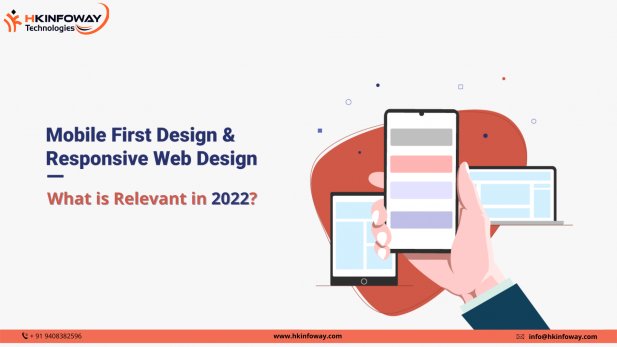Suppose you are an aspiring web designer, developer, or a business owner who is looking for web design services. In that case, you must have heard these web design terms: mobile-first or responsive, as they are quite a buzz in the web development industry currently.
Both the terms denote design approaches that focus on creating websites with keeping mobile phones in mind. As more than 58% of web traffic comes from smartphones, it has become critical to make websites more mobile-friendly.
Google also has made mobile-friendliness a parameter to rank websites at the top on the search engine result page. And there comes a concern of designing websites so that mobile users can also have a seamless surfing experience.
Mobile-first and responsive approaches deal with how the website will appear on mobile phones, then how do both methods differ if their goal is the same? To answer this question, we have to understand these web design approaches. So, keep reading the article.
What is responsive web design, and why is it still popular?
A responsive web design is designing a website for desktops first and then adjusting it to smaller screens like mobile phones and tablets. This approach was most prevalent in 2015 when people preferred to access websites from computers than smartphones.
Responsive web designs use fluid grids. It shrinks the fonts and moves elements into a single column when screen size reduces. So, when any user accesses a responsive website through mobile phones, they can seamlessly surf the site.
Responsive websites may benefit businesses whose audience access their website more through desktop or laptops than mobile phones. This is particularly the right option for B2B businesses. These businesses should continue creating sites that follow responsive design principles.
What is mobile-first design, and why we will see more of it in 2022
Mobile-first web design means designing a website for mobile devices first and then scaling it to adjust according to desktop screens. It is called a progressive advancement, which is precisely opposite to a responsive approach as it is called graceful degradation.
Mobile-first websites focus on making websites with functional elements that offer value to target users. This helps web designers remove any unnecessary features that are not relevant and create clutter.
Many companies are using this approach to design their websites. For example, Instagram started with iOS and Android app development first. They first created a mobile app and then scaled it up to the desktop version.
3 Reasons why your business need mobile-first design
Google’s ranking parameter
In July 2019, Google decided to move to mobile-first indexing. This means Google algorithms consider mobile-friendliness of the content of websites when ranking on the SERP. And this is a reflection of increasing web traffic from mobile devices. So, if your audience can’t surf your website correctly on mobile devices, the chances are high that Google won’t rank your website.
User experience
Mobile-first websites offer the best user experience. Albeit, all websites have that same goal. When designers work with small screens, they have to prioritize the vital aspects of products or services. This means they have to focus on creating a superior layout designed for touch rather than desktop clicks. For example, mobile-first websites will have more interactive buttons than text links.
Money factor
Mobile-friendliness does not only benefit user experience and ranking; there is an opportunity to make money through mobile. Hence the importance of mobile-first design. More companies advertise through smartphones than former mediums like TV and print. Social media ads feature amazing animations, and we know that media consumption is higher on mobile devices. So, this leads to more clicks on ads, which may increase website traffic.
3 mobile-first design principle
Keep your website simple
The content is crucial but does not clutter your website with lots of text and images. Instead, keep your website simple with only important content and design elements. Your web design must help your user quickly complete a task or solve a problem.
Add bright and bold CTAs
When designing for mobile devices, do not forget to add a bright and bold call-to-action that instantly catches your user’s attention. Also, use large fonts that quickly respond to user touch.
Have a thumb-friendly navigation
Creating a navigation bar is one of the crucial steps in mobile-first web design. Your navigation bar should be seamless enough to interact by thumb. This means extensive navigation as websites do not suit mobile apps as it takes too much space. Instead, you can opt for a hamburger menu that will hide navigation links, keeping the screen crisp.
Wrapping up
Although the mobile-first approach seems more prevailing than responsive design, both methods have specific circumstances and requirements that suit more. If you are not sure what to opt for, you can always ask your designer or an IT agency offering web design services.
Also read : The Evolution Of Web Design with latest Trends in 2022

